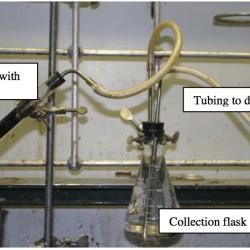Source Institutions
Source Institutions
Add to list Go to activity
Activity link broken? See if it's at the internet archive

In this activity, learners will be introduced to biomass gasification and will generate their own biomass gases. Learners generate these gases everyday on their own and find it quite amusing, but this time they’ll do it by heating wood pellets or wood splints in a test tube. They will collect the resulting gases and use the gas to roast a marshmallow. Learners will also evaluate which biomass fuel is the best either according to their own criteria or by examining the volume of gas produced by each type of fuel.
- 5 to 10 minutes
- 2 to 4 hours
- Over $20 per group of students
- Ages 14 - 18
- Activity, Experiment/Lab Activity, Lesson/Lesson Plan
- English
Quick Guide
Materials List (per group of students)
- Safety Glasses
- Lab Coats
- Latex or nitrile gloves
- 35-55 mL test tube with matching one-hole rubber stopper
- 2 Ring stands with metal test tube clamp and clamp for Erlenmeyer flask
- 3 pieces stainless steel or glass tubing, each approx. 5 cm long
- 250 mL Erlenmeyer flask with matching 2-hole stopper
- 3 pieces rubber or Tygon tubing, 2 approx. 60 cm long and 1 just shorter than the Erlenmeyer flask
- Bunsen burner
- Sink with faucet connection for tubing
- Wood pellets or wood splints (enough to fill test tube approx. 3/4 full)
- Regular-sized Marshmallows (not the minis)
- Skewers for roasting the marshmallows
- 1 large Ziploc bag for test tube disposal
- A variety of types of biomass such as: crushed wood pellets or wood splints, dried grass, nut shells, manure, and corn stover
- 200 mL graduated cylinder
- Balance
Subjects
-
Engineering and Technology
-
Engineering
- Bioengineering/Biomedical Engineering
- Chemical Engineering
-
Engineering
-
Mathematics
- Algebra
-
Data Analysis and Probability
- Data Analysis
- Data Collection
- Data Representation
-
Measurement
- Units of Measurement
-
Physical Sciences
-
Heat and Thermodynamics
- Heat and Temperature
- Heat Transfer
- Electricity and Magnetism
-
Energy
- Energy and Power
-
Chemistry
- Chemical Reactions
-
States of Matter
- Gases
-
Heat and Thermodynamics
-
The Nature of Science
-
The Scientific Process
- Conducting Investigations
- Gathering Data
- Formulating Explanations
- Communicating Results
-
The Scientific Process
Informal Categories
- Food and Cooking
- Nature and Environment
Audience
To use this activity, learners need to:
- see
- read
- touch
Learning styles supported:
- Uses STEM to solve real-world problems
- Involves hands-on or lab activities
Other
Components that are part of this resource:
Includes alignment to state and/or national standards:
This resource is part of:
Access Rights:
- Free access
By:
- Benson, Eric ; Highfill, Melissa
Rights:
- All rights reserved, National Renewable Energy Laboratory,
